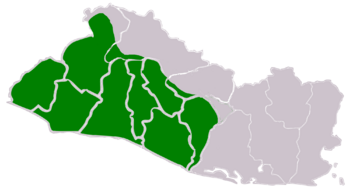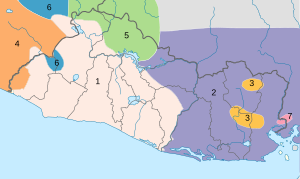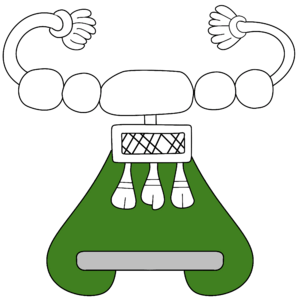Cuzcatlan facts for kids
Quick facts for kids  |
|
| Capital | Kuskatan |
|---|---|
| Official languages | Nawat |
| Government | Tributary Monarchy |
| History | |
|
• Established
|
c. 1200 |
|
• Disestablished
|
1528 |
| Today part of | El Salvador |
Cuzcatlan (also called Kuskatan in Nawat or Cuzcatlan in Nahuatl) was a powerful group of states in Central America long before Europeans arrived. It stretched from the Paz River to the Lempa River, covering most of western El Salvador. Spanish explorers later called the people of this land the Pipils or Cuzcatlecos.
We don't have many ancient books or records (called codices) from Cuzcatlan. However, Spanish writers like Domingo Juarros said that some did exist but are now lost. The Pipil people's language (Nawat), art, and temples show strong influences from the Maya and Toltec cultures. This suggests they had close ties with the Itza people in Yucatan. Many believe the first settlers came from the Toltec people in central Mexico, especially from Puebla, around the 10th century AD.
The people of Cuzcatlan were called Pipils in old stories. This word often means "boys" or sometimes "young nobles." The Spanish and their allies from Tlaxcala and Mexica, who spoke a different type of Nahuatl, thought the Pipils spoke a simpler version of their language. Another idea is that "Pipil" came from "Pipiltin," a Nahua social class meaning "nobles," and that the Pipils believed they were descendants of a god named Nanahuatzin.
Contents
What Does "Cuzcatlan" Mean?
The name Kuskatan likely comes from the Nawat words "kuskat" (meaning necklace) and "kuzti" (meaning jewel). When combined with "tan" (meaning "place of" or "among"), it means "place of jewel necklaces." In the Nahuatl language, a similar word is Cuzcat(l)an.
Where Did the Pipil People Come From?

The Pipil people are an indigenous group who lived in western El Salvador and parts of Honduras. They are a subgroup of the Nahua people, also known as Nawats or Southern Nahuas. The Nahua people originally lived in Mexico. Waves of Pipil people migrated to the area that became Cuzcatlan. It's thought that the first Pipil groups arrived in this Mesoamerican land as early as 3000 BCE. Another group of Nahua migrants, known as the Izalco Pipils, came in the 10th century.
The Nawat Pipil arrived in El Salvador around 900 AD. When they got there, they had to fight for their new land because of ongoing Mayan civil wars. However, the Pipil also had many Mayan allies, possibly due to shared beliefs in gods like Quetzalcoatl. Over time, smaller city-states like Tehuacán, Chalchuapa, and Cihuatán joined the Cuzcatlan group of states.
Legend says that the capital city of Cuzcatlán was founded by an exiled Toltec leader named Ce Acatl Topiltzin around 1054. By the 13th century, the Pipil city-states likely united, and by 1400, they had a system where rulers inherited their power. The Pipil people helped Cuzcatlan grow and called their region the "Land of the Jewel." They used farming and building methods that were greatly influenced by ancient Mayan culture. The Pipil people lived alongside other indigenous groups, such as the Lenca and Pokomam Maya, and shared similar traditions. They built towns and cities that could support many people, thanks to their advanced irrigation systems for farming.
What Was the Land Like?
The Lordship of Cuzcatlan covered about 10,000 square kilometers. This large area included much of central and western El Salvador. It had many different environments, from the coast to mountains over 2,000 meters high.
How Did Cuzcatlan's Economy Work?
Cuzcatlan's economy was shaped by its indigenous Pipil people and later by the Spanish after they arrived. Before the Spanish, the economy was based on trading farm products and handmade goods, like colorful textiles.
Cocoa beans and Indigo dye were very important crops. They were grown carefully in the Izalcos area and traded throughout the region. Indigo, especially, was a huge part of Cuzcatlan's economy, used for both farming and industrial products. Growing so much indigo and cocoa required a lot of work, which was done by the local indigenous people. This system helped the landowning class grow richer. The production of these crops involved building a complex system of irrigation, some parts of which can still be seen today. Cocoa beans were even used as a form of money in the region.
Other crops grown by the Pipil included cotton, squash, corn, beans, fruits, balsam, some peppers, and chocolate. However, chocolate was a special treat only for the ruling class. They also did some mining for gold and silver, but these metals were not used as money. Instead, they were offered to their many gods. Only priests and the ruling family could wear gold and silver as decorations.
After the Spanish arrived, the economy changed a lot. Pedro de Alvarado began forcing indigenous people into labor, first in Guatemala and then in Cuzcatlan during his invasion in 1524. As more Spaniards settled, it became common for their homes to have indigenous slaves, often women who worked as servants. Many of these slaves were captured in wars or traded. Those not working in households were forced to help with farming.
Settlements were often assigned to an "encomienda" system. This meant they had to provide specific goods as payment to the Spaniards. These goods usually included food like maize (corn), beans, chili peppers, turkeys, venison, salt, dried fish, honey, and beeswax. They also had to provide firewood, woven cotton clothes, and other clothing. If settlements failed to provide these goods, they often faced threats and violence.
Spanish industries also greatly changed Cuzcatlan's economy. These new industries, often run by Spanish overseers and indigenous mestizo workers (people of mixed heritage), began to take over. One important industry was making war supplies. Between 1525 and 1539, there were many raids in the area, leading to forced labor for making war supplies like iron. Building and architecture also became important due to Spanish influence. This industry also relied on male indigenous labor for making bricks, roof tiles, and charcoal, and for working as blacksmiths.
What Did They Believe In?
From Spanish writings and archaeological discoveries, we know that the Señorío de Cuzcatlán had a well-organized religion. They believed in a "Creator" or "Divine energy of life" called Tiyut/Teotl. They had priests and honored their first ancestors. One important pilgrimage site was a sanctuary dedicated to the ancestor goddess Nuictlán, built by Cē Ācatl Topiltzin Quetzalcoatl on Lake Güija. During wartime, human sacrifice was sometimes practiced as part of a warrior's code of honor.
Gods and Spirits
The people of ancient Cuzcatlán likely believed in cosmic powers linked to gods such as Xipe Totec, Quetzalcoatl, Ehécatl, Tláloc, Chacmool, Tonatiuh, and Chalchiuhtlicue. Some gods were especially important to Cuzcatlán, like Itzqueye. Téotl, Quetzalcoatl, and Itzqueye were three of the most significant figures in their spiritual beliefs.
What About Their Music?
Cuzcatlan was close to other indigenous groups, so their music included new ideas and traditions borrowed from others. A special instrument they used was a slit drum, which the Cuzcatlan people called tepunahuaxtles. This drum was not unique to them; it's believed to be very old in Mesoamerica. The word comes from the Aztec word Teponaztli, meaning drum. In Aztec ceremonies, this drum was used for religious, military, and royal events, similar to how it was used in Cuzcatlan.
How Did Cuzcatlan Fall?
After the Aztec Empire was conquered, Hernán Cortés sent Pedro de Alvarado to conquer the native states further south. Alvarado first made alliances with or defeated Mayan groups in the highlands. On June 6, 1524, he crossed the Paz River with his soldiers and thousands of Kaqchikel Mayan allies. He then defeated the leader of Izalco, which was the first major city-state on the way to Cuzcatlan. Fierce battles were fought to defend Izalco in places like Acaxual (today Acajutla) and Tacuzcalco.
On June 17, Alvarado arrived in Cuzcatlan. Some people accepted his rule, while others fled to the mountains. After Cuzcatlan fell in 1525, Pedro de Alvarado's cousin, Diego de Alvarado, founded the town of Villa De San Salvador. Over the next three years, the Nahuas of Cuzcatlan tried several times to destroy the new town. This led to the decision to move the town a few kilometers south to its current location. This new spot was in a valley known as "the valley of the hammocks" (because of frequent earthquakes) next to the Quezaltepeque (San Salvador) volcano.
What Is Cuzcatlan's Legacy Today?
Archaeological sites in El Salvador, like the Tazumal complex, show ancient Mesoamerican stonework. This includes pyramids that look like those found at Toltec temple sites. Other important sites are San Andrés, Cara Sucia, Joya de Cerén, and Cihuatán. However, Cuzcatlan is not known for huge, grand buildings like the Classical Maya. This is because later Spanish rulers took apart most of the palaces and temples over centuries to build walls and roads. El Salvador is one of the most looted archaeological places in the Western Hemisphere, with many artifacts, like the Izalco Jaguar heads, being stolen in recent years.
In 2020, the Kuskatan football team joined ConIFA. This is a football organization for teams that are not part of FIFA.
See also
In Spanish: Señorío de Cuzcatlán para niños


